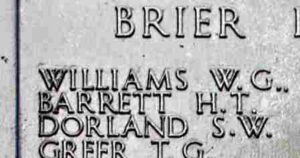Aberarth is a small seaside village situated on the A487 coastal road between Aberystwyth and Cardigan, on the mouth of the River Arth. The village was founded around the time of the Norman invasion, when Dinerth Castle was built further up the river valley. Llanddewi Aberarth Church sits on a hill about half a mile south of the village, and is dedicated to St David. The original war memorials for the village are situated inside the Church and are made of white marble on a black background, the reading desk forming part of the War Memorial. Recently a new war memorial was commissioned and was unveiled in November 2015, located on community council land near the Welsh Coast Path. The new memorial commemorates eight men from the village who fell, four from each World War, while the Church memorials commemorate seven men of the Parish of Llanddewi Aberarth who fell during World War One and six from World War Two.
The Great War, 1914-1918
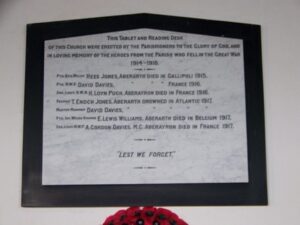
The original Church WW1 Memorial
Albert Gordon Davies, MC, Second Lieutenant, Royal Welsh Fusiliers. Albert was born at Aberaeron in 1889, the son of John and Elizabeth Alban Davies, of Tanyfron Villa. He was commissioned into the 7th Battalion (Merioneth & Montgomery), Royal Welsh Fusiliers during 1916, but was subsequently attached to another battalion in France. Albert was probably wounded at Messines in 1917, during an action which led to him being awarded the Military Cross. His citation, which was published in the London Gazette of 25 August 1917, read: For conspicuous gallantry and devotion to duty. During an attack in complete darkness, he pushed through our own barrage to the enemy line in order to restore the direction which his platoon had lost, afterwards leading them to their objective. He displayed magnificent gallantry throughout. Sadly Albert died of his wounds at Bailleul on 1 August 1917, aged 27. He is buried at Bailleul Communal Cemetery Extension, France. Albert is commemorated only on the old war memorial.
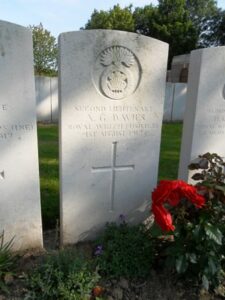
David Davies, Second Mate, Mercantile Marine. David was the son of Thomas and Margaret Davies, of 1, The Terrace, Aberarth. He served with the Mercantile Marine aboard the SS Rhydwen, a Cardiff registered steamer. On 18 April 1917, Rhydwen was on voyage from Galveston to Cardiff with a cargo of wheat, when she was torpedoed and sunk by the German submarine U-67, with the loss of six lives. David was 45 years old when he died that day, and is commemorated on the Tower Hill Memorial, London. David is commemorated on both the old and new memorials.
David Davies, Private, 45139, Royal Welsh Fusiliers. David was the son of David and Jane Davies, of Brysig Bach, Pennant, Aberarth. He enlisted at Lampeter on 8 February 1916 into the South Wales Borderers, and was posted to France on 23 February 1917, joining the 10th Battalion, Royal Welsh Fusiliers, which was attached to 76 Brigade, 3rd Division. David joined the division in time for its move from the Somme to Arras. He was killed in action during the opening of the Battle of Arras on 30 April 1917. David was 30 years old, and is commemorated on the Arras Memorial, France. There was some confusion about David’s identity after his death, as his mother did not seem to think he was serving with the Royal Welsh Fusiliers, but with a Labour Company of the King’s Liverpool Regiment, with the number 44639. He was in fact transferred from this unit to the RWF. He had then been mixed up with another D. Davies, of Abergele, whose mother was incorrectly informed of her son’s death, only to receive a letter saying he was alive and well. David is commemorated only on the old war memorial.
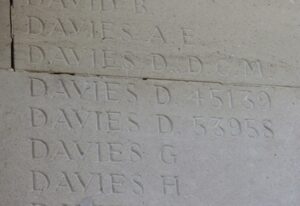
Thomas Evans, Master, Mercantile Marine. Thomas was the son of Thomas and Catherine Evans, of Laura, Aberarth, and the husband of Annie E. Evans, of Awelfa, Aberarth. He was a long serving Mariner and by the outbreak of war was Master of the schooner Therese Heymann. On 25 December 1914 she left the Tyne en-route for Savona, Italy, and was never seen again. Thomas was among 21 men lost in the disappearance of the ship. He was 52 years old and is commemorated on the Tower Hill Memorial, London. Thomas is also commemorated on the family grave at Llanddewi Aberarth. He is commemorated on the new memorial only.
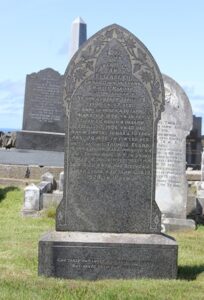
John Hugh Jones, Able Seaman, Mercantile Marine. John was born on 15 August 1900, the son of David and Margaret Jones, of Glandwr, Aberarth. He joined the Mercantile Marine, and served aboard H.M.T. Lizzie, a trawler which had been hired by the Admiralty and converted for minesweeping duties. John died in France on 28 January 1919, aged 19, and is buried in Ste. Marie Cemetery, Le Havre, France. John is commemorated only on the old war memorial.
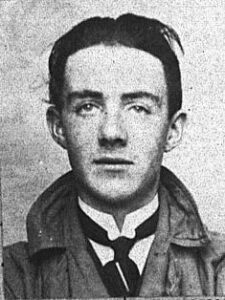
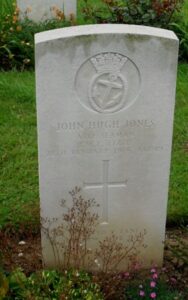
Rees Jones, Welsh Regiment. The original Church memorial states that Rees served with the 8th Battalion, Welsh Regiment, and died at Gallipoli in 1915. There is no man of that name who fell whilst serving with the 8th Welsh, nor any man who served with any of the Welsh Regiment battalions at Gallipoli (4th, 5th and 8th). Rees is commemorated only on the old war memorial.
Thomas Enoch Jones, Second Mate, Mercantile Marine. Thomas was the son of Evan and Jane Jones, of Rock Villa, Aberarth. He served with the Mercantile Marine aboard the SS Goathland, a Whitby registered merchant steamer. On 4 July 1917, Goathland was on voyage from St Nazaire to the Gulf of Mexico in ballast, when she was torpedoed and sunk by the German submarine U-84, with the loss of 21 lives. Thomas was 24 years old when he died that day, and is commemorated on the Tower Hill Memorial, London. Thomas is commemorated on both the old and new memorials.
Jenkin Morgan, Able Seaman, Z/2503, Royal Naval Volunteer Reserve. Jenkin was born on 23 February 1885, the son of Evan and Elizabeth Morgan, of Snow Hill, Pennant, Aberarth. He worked as a collier prior to the war and lived at Sybil House, Ynismudu, near Pontardawe. Jenkin enlisted on 16 November 1915 into the Royal Naval Volunteer Reserve, and was posted to Hawke Battalion in France on 10 July 1916. The battalion was attached to the 63rd (Royal Naval) Division, and saw heavy fighting during the Battle of the Ancre later that year. Jenkin was killed in action on the Ancre on 13 November 1916, and is buried in Ancre British Cemetery, Beaumont Hamel, France. He does not appear to be commemorated locally.
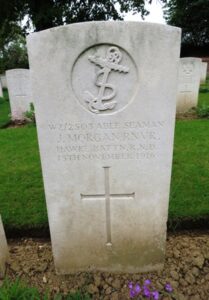
Henry Loyn Pugh, Second Lieutenant, South Wales Borderers. Henry was born in 1888, the Son of Thomas and Mary Pugh, of 7, Alban Square, Aberaeron. Educated at Llandovery prior to the war, Henry was a Councillor, and also a Scoutmaster at Aberaeron prior to his enlistment in the Inns of Court Regiment. He was commissioned into the 3rd Battalion, South Wales Borderers in October 1915. Henry was then attached to the 1st Battalion, South Wales Borderers, which was attached to 3 Brigade, 1st Division, and he arrived in France on 29 August 1916. The Division was on the Somme, and in early September 1916, were in support of the Gloucester’s and Welsh Regiment in the fighting for High Wood. Henry was wounded on 9 September 1916, and evacuated to 36 Casualty Clearing Station at Heilly. Sadly he died of his wounds on 11 September 1916. He was 29 years old, and is buried at Heilly Station Cemetery, Mericourt-L’Abbe, France. Henry is commemorated only on the old war memorial.
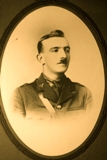
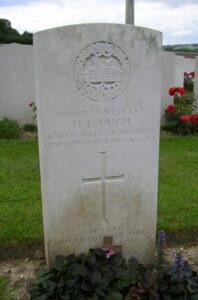
Evan Lewis Williams, Private, 901, Welsh Guards. Evan was the son of John and Mary Williams, of Frondolau, Aberarth. He enlisted at Neath into the 1st Battalion, Welsh Guards. The Regiment was raised by Royal Warrant of 26 February 1915, at White City, before landing at Le Havre on 18 August 1915, becoming attached to 3rd Guards Brigade, Guards Division. The Division saw its first major action during the Battle of Loos on 25 September 1915, remaining in the area during the coming months, where they also fought in the subsequent Action of Hohenzollern Redoubt. In July 1916 the Division moved to the Somme, where they fought at the Battle of Flers-Courcelette, and then at the Battle of Morval, capturing Lesboeufs Village. They remained here for the winter, and in the summer of 1917 moved to Ypres, taking up the line on the left flank of the 38th (Welsh) Division. Here the Guards took part in their famous assault on Pilckem Ridge on 31 July 1917. Evan was however wounded during the build up to the battle. He died of his wounds on 28 July 1917, aged 20 and is buried in Dozinghem Military Cemetery, Belgium. Evan is commemorated on both the old and new memorials.
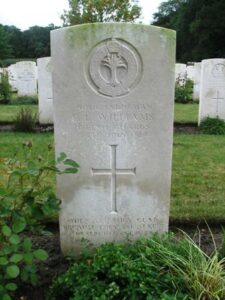
World War Two, 1939-1945
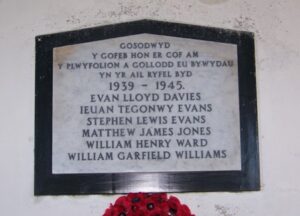
The original Church WW2 Memorial
Evan Lloyd Davies, Leading Aircraftman, 1412679, Royal Air Force. Evan was the son of Benjamin and Jane Davies, and the husband of Violet Jane Mildred Davies, of Camden Town, London. After the invasion of occupied Europe, Evan was posted to the B.S.R.U. (Base Signals and Radar Unit). On 7 November 1944, Evan was among a large party of RAF servicemen who, along with trucks and supplies for the RAF in Belgium, were aboard the Landing Ship LST-420. It was unable to enter the port of Ostend because of a severe storm and the captain decided to return to England, but hit and mine, split in two, and sank. Fourteen officers and 224 other ranks were lost, with only 31 men saved. Evan was among the dead. He was 34 years old, and is commemorated on the Runnymede Memorial, Surrey. Evan is commemorated only on the old war memorial.
Ieuan Tegonwy Evans, Trooper, 7916893, Royal Armoured Corps. Ieuan was the son of Thomas and Annie Elizabeth Evans, and the husband of Margaret Walkden Evans, of Douglas, Isle of Man. He served with the 44th Royal Tank Regiment, Royal Armoured Corps during the North African campaign. After the Axis forces had been defeated in Tunisia in 1943, the Allies began their liberation of Italy. Ieuan was killed in Italy on 8 November 1943. He was 33 years old, and is buried in Sangro River War Cemetery, Italy. Ieuan is commemorated on both the old and the new memorials.
Stephen Lewis Evans, Master, Merchant Navy. Stephen was the husband of Sarah Ellen Evans, of Cartref, Aberarth. He served with the Merchant Navy aboard the SS Corheath, a London registered steamer. On 24 January 1941, Corheath was en route from Portsmouth to Blyth in ballast, when she was mined and sunk with the loss of three lives. Stephen was 56 years old when he died that day. His body was later recovered from the sea, and Stephen is buried in Llanddewi-Aberarth (St. David) Churchyard. Stephen is commemorated on both the old and the new memorials.
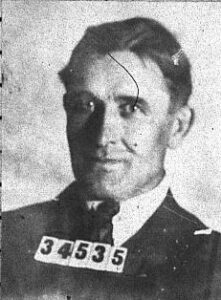
Matthew James Jones, Third Officer, Merchant Navy. Matthew was the son of Thomas Abel and Jane Jones, and the husband of Margaret Elizabeth Jones, of Aberarth. He served with the Merchant Navy aboard the SS Stanburn, a London registered steamer. On 29 January 1940, Stanburn was in the North Sea, when she was bombed and sunk by German aircraft, which also fired on survivors in the ships lifeboats. Twenty-two men were killed of her crew of twenty-five. Matthew was 39 years old when he died that day. His body was washed ashore some time later, and he was brought home for burial at Llanddewi-Aberarth (St. David) Churchyard. Matthew is commemorated on both the old and the new memorials.
William Henry Ward, Gunner, 891226, Royal Artillery. William was the Son of Mr. and Mrs. T. A. Ward, of Llanbadarn. He served with 146 (The Pembroke Yeomanry) Field Regiment, Royal Artillery. The 146th Field Regiment was raised in Cardiganshire, and joined the Eighth Army in time to take part in the Battle of El Alamein. Afterwards it became part of the 7th Armoured Division, taking part in the advance to Tripoli, and helping defeat Rommel’s counter-attack at Medenine. William was killed in North Africa on 28 March 1943. He was 27 years old, and is buried at Sfax War Cemetery, Tunisia. William is commemorated only on the old war memorial.
William Garfield Williams, Master, Merchant Navy. William was the son of Oliver and Catherine Williams, of Aberaeron. He served with the Merchant Navy aboard the SS Brier Rose, a Liverpool registered steamer. On 26 March 1941, Brier Rose was in the Irish Sea, when she was lost, supposed by enemy action, with the loss of all her crew. William was 35 years old when he died that day, and is commemorated on the Tower Hill Memorial, London. William is commemorated on both the old and the new memorials.
